Day 2 of a long weekend of tours and today it was off down to the Broads. The weather forecast throughout the last week had foretold heavy rain all day today. Thankfully the Met Office can be relied upon for one thing… to get it wrong! We barely saw a drop of rain – it was cloudy and rather windy, but mercifully dry.
We started with a drive along the coast road from Sea Palling. We hadn’t gone very far when we spotted our first Cranes of the day. They were in a field some distance from the road, but unfortunately we had nowhere to stop. We pulled into a convenient layby and walked back with the scopes to the spot from where we could see them, but even though we were several fields away they started to look nervous. We just had time to get a look at them in the scope before they took off and dropped down a little further over, out of view.
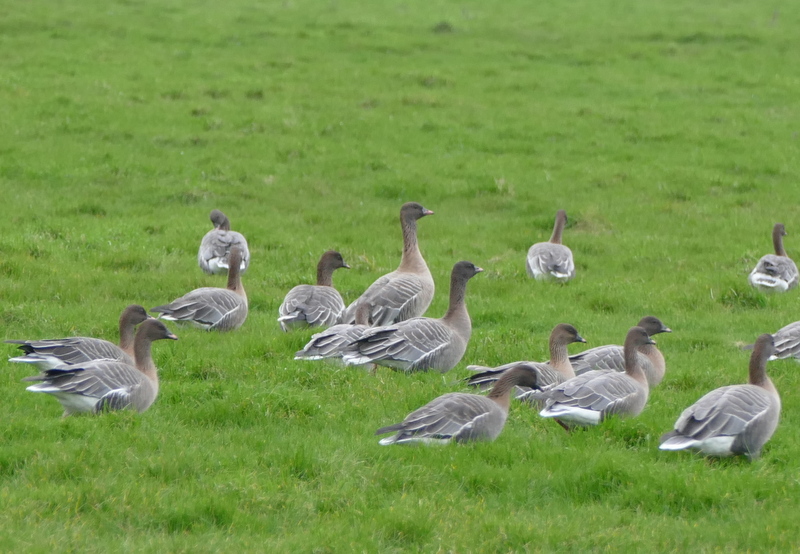 Pink-footed Geese – one of several small groups this morning
Pink-footed Geese – one of several small groups this morning
We carried on along the road, scanning the fields. We came across a couple of small groups of Pink-footed Geese in the grazing meadows. Further along, south of Horsey Mill, we pulled over and got out for a good look round. There was an even bigger flock of Pink-footed Geese here – at least until the farmer arrived. He seemed to object to the Mute Swans in the fields across the road, and shot into the air scaring everything off apart from one stubborn Mute Swan.
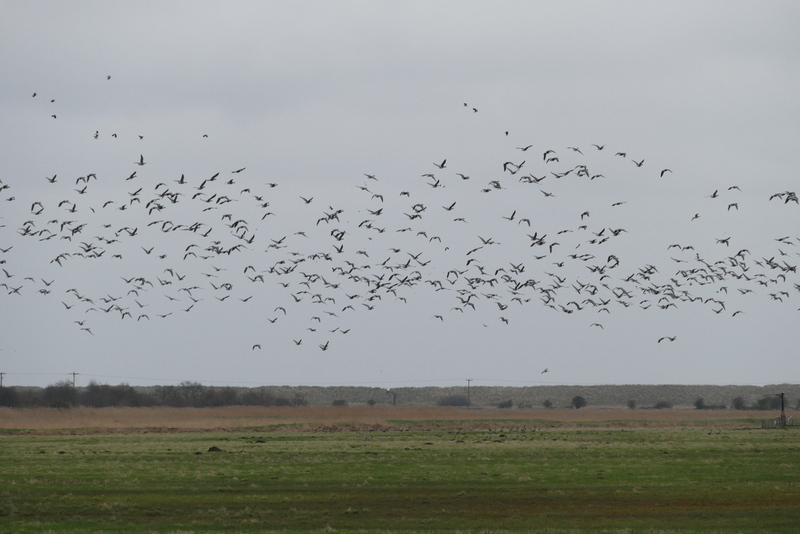 Pink-footed Geese – scared off by one of the local farmers
Pink-footed Geese – scared off by one of the local farmers
Before the farmer arrived, there was actually quite a nice selection of birds to look at. There were large numbers of Lapwing out on the grass and a smaller flock of Golden Plover. On the flooded field the other side of the road, we were rather surprised to see a small group of five Knot. Several Marsh Harriers were circling over the reeds behind, and two of them started diving at each other. But we couldn’t find any more Cranes here.
We decided to move on and drove round to Ludham Airfield. Once again, we could see the swans before we left the main road, a white smear across the fields from a distance. We drove round and positioned ourselves where we wouldn’t disturb them as we got out of the car to look at them through the scopes.
 Bewick’s Swan – there were at least 85 today
Bewick’s Swan – there were at least 85 today
The swans were in two groups today, with most of the Bewick’s Swans sat down in the middle of the winter wheat, whereas most of the Whooper Swans were over on the edge of the field. It was as if they had fallen out with each other and were now not speaking! On closer examination, we did find a small group of four Bewick’s Swans closer to the Whoopers and three Whooper Swans sleeping in with the Bewick’s, so there were obviously a few swans which couldn’t pick sides.
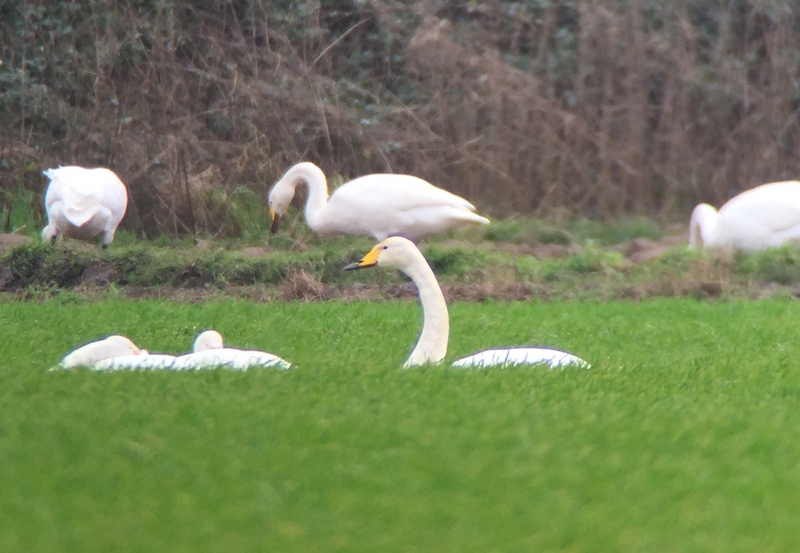 Whooper Swans – over 40 today, mostly on the edge of the field
Whooper Swans – over 40 today, mostly on the edge of the field
Despite their attempt at separating by species, we could still get a good comparison between the two – the Whooper Swans noticeably larger, longer necked and longer billed, and with the yellow coming down the bill into a point, unlike the more squared off yellow on the Bewick’s Swans’ bills. There were at least 85 Bewick’s Swans here today, a little down on recent counts, but over 40 Whooper Swans still.
We decided to head down to Great Yarmouth next to look for some gulls. We stopped briefly on the way to see if there was anything on Rollesby or Ormesby Broads. It was pretty rough out in the middle – there were just a few Coots and Tufted Ducks. A Great Crested Grebe swam out from close in to the bank as we pulled up and a very white-headed Cormorant dropped down from a post into the water and swam past. A Grey Heron crept out of the reeds to the water’s edge.
We had wanted to see the Glaucous Gull at Great Yarmouth, but there was not a sign of it today around any of its usual haunts. It seems to have a nasty habit of going missing at times. We had to content ourselves with going to see the Mediterranean Gulls on the beach instead.
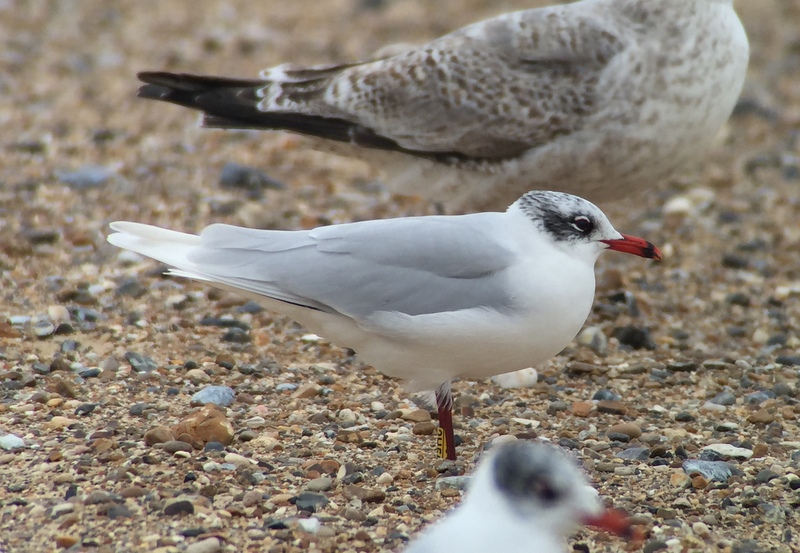 Mediterranean Gull – a colour-ringed adult in winter plumage
Mediterranean Gull – a colour-ringed adult in winter plumage
There were only three Mediterranean Gulls on the beach when we arrived and they promptly flew off. Someone else was obviously feeding them elsewhere. Quickly deploying some choice sliced white bread, they soon came back and brought a few of their friends with them. They were mostly winter adults, but a couple of 2nd winters arrived too. After squabbling over the bread, they all settled on the beach so we could get a good look at them. A crafty Starling came along and ran around our feet after the crumbs.
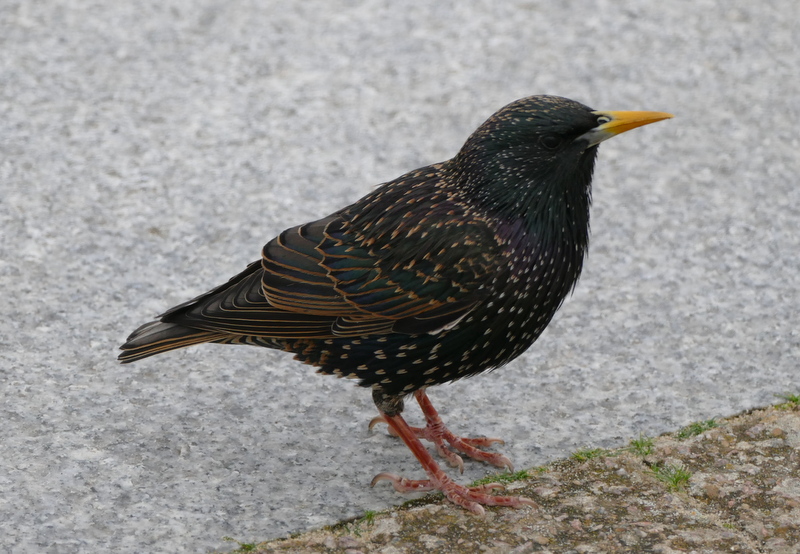 Starling – came round our feet for the crumbs
Starling – came round our feet for the crumbs
We had a quick look out to sea. There is a large sandbank offshore called Scroby Sands and we could see a large number of seals pulled out of the water. At one end, a black mass on the sand was a big flock of Cormorants – there can be a huge number of them out here. A few Kittiwakes were struggling past into the wind.
From there, we drove inland and down to Strumpshaw Fen. As we got out of the car, we could hear the twittering of Siskins and looked up to see lots of them in the alders. A noisy flock of Long-tailed Tits came through the car park. The reserve itself seemed to be very quiet again, so we just ate our lunch and moved on.
The grazing marshes at Buckenham seemed to be strangely deserted today. There were very few geese – just a few Canada Geese and an odd-looking Canada x Greylag Goose hybrid – but that is not necessarily unusual. However, there were also very few ducks and a distinct shortage of Lapwings and Golden Plover. Presumably, something had disturbed everything off here today. A Chinese Water Deer provided a brief distraction.
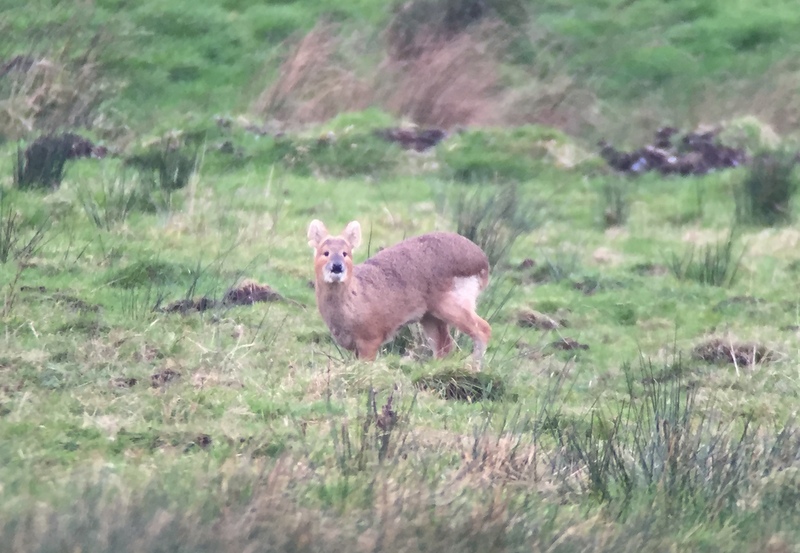 Chinese Water Deer – on the grazing marshes at Buckenham
Chinese Water Deer – on the grazing marshes at Buckenham
Given the lack of birds, we decided not to walk out at Buckenham, but went round to Cantley instead. At least we found the geese here. There was a big flock of Pink-footed Geese over towards the river. We got the scopes on them and, scanning carefully, we started to find a few White-fronted Geese in with them. There were probably quite a few there, because the more we scanned, the more we found.
As we were looking through the geese, we found something different on the ground in the middle of them – a Peregrine. The geese seemed particularly unconcerned, and more flew in and landed all around it. The Peregrine was hopping about in the grass and perching up on tussocks. Eventually it took off and swept round over the marshes a couple of times, flushing the Lapwings and Golden Plover, before flying straight towards us and then turning off towards Cantley Beet Factory.
 Peregrine – flew past us after standing in with the geese
Peregrine – flew past us after standing in with the geese
The afternoon was getting on, and we wanted to get to Stubb Mill in good time for the roost, so we started to make our way back north. We tried various more sites where Cranes are regularly to be found, but there was no sign of any anywhere today. Perhaps they were put off by the wind, which had become very gusty by this stage.
Our timing was right today though. As we walked out towards the Stubb Mill watchpoint from the car park at Hickling Broad, first two Cranes flew over the marshes, and dropped down towards Heigham Holmes. We could see their long necks and long trailing feet. Then we turned to see a ringtail Hen Harrier coming low across the grass in front of the reeds, right in front of us – a great view. It flushed a few Snipe and a big flock of Teal as it went, before turning and working its way back over the reeds. Even better, the sky just brightened a little as we arrived.
There were not so many Marsh Harriers over the reeds and bushes this evening. It was hard to tell how many were already in, or whether they were planning to arrive late due to the wind. There were around 6-8 flying around over the trees at any one time, and a few more trickled in while we were waiting. However, we were treated to a good display from the Hen Harriers. First, another ringtail flew south past the assembled crowd, low over the grazing marshes just in front. Later on, another ringtail flew in from the east.
There was no sign of any Cranes from the watchpoint when we arrived there. Then suddenly the resident pair, which is usually always around, flew in from the reeds at the back and dropped down onto the grass where they should have been. They had obviously been hiding – possibly due to the wind. Where they landed they were out of view at first, but eventually walked out to where we could see them and a little later flew across and landed in the open. Much better!
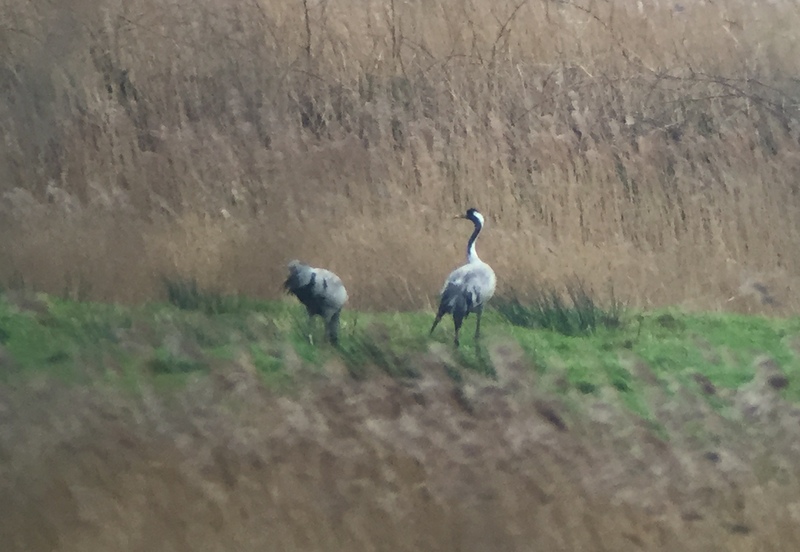 Cranes – the resident pair finally came out of hiding
Cranes – the resident pair finally came out of hiding
There was another Chinese Water Deer out on the marshes, but suddenly we spotted two larger deer further back. A couple of Red Deer were grazing on the grass. At one point, the two Cranes walked out in front of the two Red Deer – not a combination you see every day.
While we were watching them, someone shouted and three more Cranes flew over from the north. They came in slowly over the trees, up in the sky at first – helpfully where we could see them well – before dropping down below treetop level and disappearing from view towards Horsey Mere. That took us to a total of nine Cranes for the day!
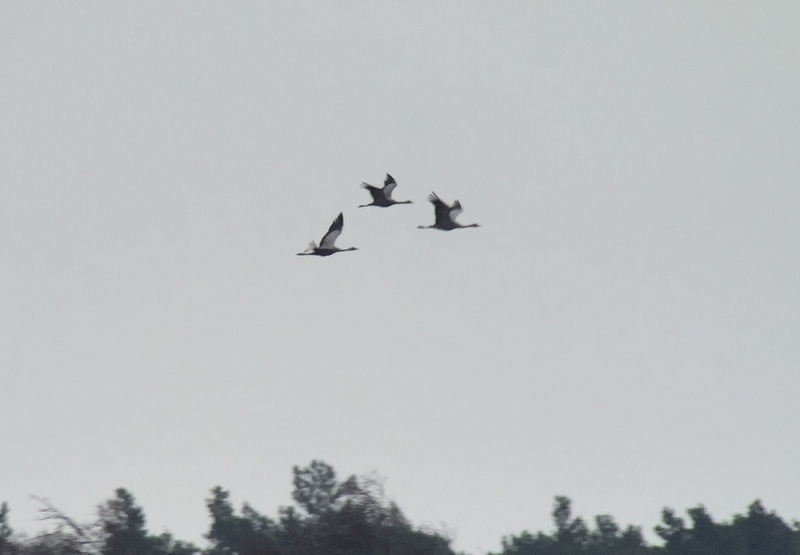 Cranes – these three flew across, in front of the watchpoint
Cranes – these three flew across, in front of the watchpoint
The light was starting to fade and we had enjoyed a very productive session at Stubb Mill, so we decided to head back. As we turned to go, we could hear the Cranes bugling out across the marshes, a fitting way to end the day.
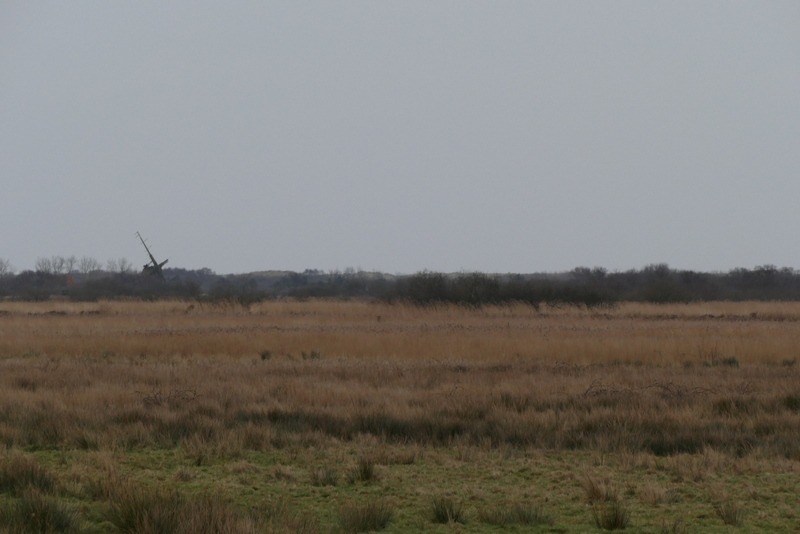 Stubb Mill Watchpoint – the view across the marshes to the ruined mill
Stubb Mill Watchpoint – the view across the marshes to the ruined mill
















